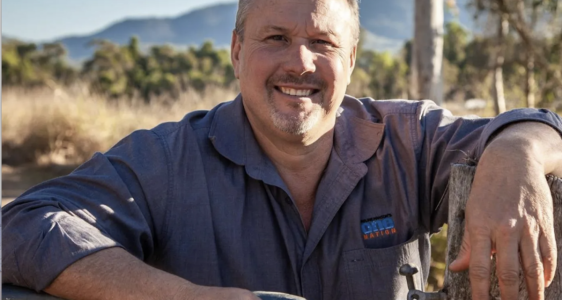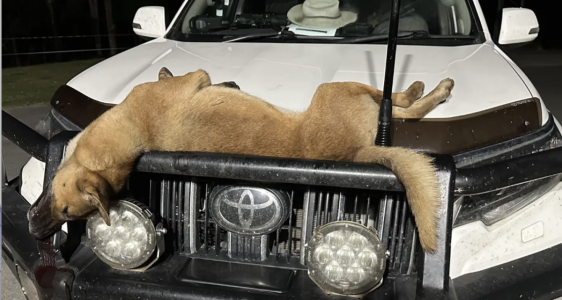‘Irresponsible thing’: Aussie MP's act involving wild dog sparks fury
By
Seia Ibanez
- Replies 22
Content Warning: This article contains descriptions of animal harm and death, which may be distressing to some readers. Discretion is advised.
In a tale that has sparked widespread fury and debate across the nation, a Queensland Member of Parliament's decision to kill a dog in what he describes as an act of retribution has left Australians deeply divided.
Steve Andrew, a One Nation representative for the seat of Mirani, took to social media to defend his actions after a dog, which he referred to as 'wild', fatally mauled a 'prized ram' valued at $25,000 on a local property.
The contentious issue came to light when Andrew shared a confronting image of the deceased animal draped over the bonnet of his ute on his social media.
His post, which celebrated the killing of the dog that 'came back for seconds' so he could ‘meet his maker’, has been met with a barrage of criticism.
The dog, which bore a resemblance to a dingo, was accused of attacking and killing the valuable ram.
Andrew's post read, 'This bloke mauled and killed a $25,000 ram trying to protect his herd....They are getting bolder and closer by the day.'
The public response was swift and polarized.
Wildlife advocates and concerned citizens quickly condemned the act, pointing out the potential ecological repercussions of such killings and the importance of apex predators like dingoes in the Australian ecosystem.
Critics argued that such actions could disrupt the local food chain and might even increase the likelihood of stock losses due to imbalances caused by the removal of these native animals.
'Despicable human...what is wrong with you killing wildlife and doing so with no awareness of their value to our ecosystem,' one outraged commenter wrote.
Others expressed concern that the MP's public display could encourage indiscriminate killing of dingoes.
‘Sure, this dingo became a problem for you, and you dealt with it. Sharing it in this way publicly will likely encourage others without deeper understanding to indiscriminately kill dingoes, which only further fuel the problem in the long term,’ another wrote.
‘It’s an irresponsible thing for a politician to do.’
In Queensland, under the Biosecurity Act 2014, landholders are legally required to control wild dogs, including dingoes, on their land.
The government permits the 'management' of these animals, including lethal measures, in certain protected areas under specific conditions.
‘Well done, I applaud this when these animals come in and kill domestic animals, they’re now classed as FERAL!, a person commented in Andrew's defence.
‘The carnage a dingo leaves attacking domestic animals is soul-destroying and heartbreaking.’
Andrew, also a licensed pest controller, personally responded to many of the comments on his post. He argued that his actions were justified and within the bounds of the law.
The owner of the slain ram described the animal as her ‘prized’ possession.
‘It was quite disturbing, given he was our little prized ram,’ she said.
The controversy has also sparked a discussion about the terminology used to describe Australia's native canines.
Dr Kylie Cairns and her team have conducted DNA research that suggested many animals labelled as 'wild dogs' are, in fact, pure dingoes.
Governments' use of the term 'wild dog' when controlling populations to protect livestock versus 'dingo' when conserving them in national parks has led to public confusion about the nature of the animals being targeted.
‘This leads to confusion with the general public not understanding the animals that are being killed are dingoes. Quite often, people will say dingoes and wild dogs…when they’re not two separate things,’ she said.
‘So making sure that our language is clear means that people understand what management actions are being taken.’

How do you feel about the actions of the MP and the broader implications for wildlife management in Australia? Share your stories and perspectives in the comments below.
In a tale that has sparked widespread fury and debate across the nation, a Queensland Member of Parliament's decision to kill a dog in what he describes as an act of retribution has left Australians deeply divided.
Steve Andrew, a One Nation representative for the seat of Mirani, took to social media to defend his actions after a dog, which he referred to as 'wild', fatally mauled a 'prized ram' valued at $25,000 on a local property.
The contentious issue came to light when Andrew shared a confronting image of the deceased animal draped over the bonnet of his ute on his social media.
His post, which celebrated the killing of the dog that 'came back for seconds' so he could ‘meet his maker’, has been met with a barrage of criticism.
The dog, which bore a resemblance to a dingo, was accused of attacking and killing the valuable ram.
Andrew's post read, 'This bloke mauled and killed a $25,000 ram trying to protect his herd....They are getting bolder and closer by the day.'
The public response was swift and polarized.
Wildlife advocates and concerned citizens quickly condemned the act, pointing out the potential ecological repercussions of such killings and the importance of apex predators like dingoes in the Australian ecosystem.
Critics argued that such actions could disrupt the local food chain and might even increase the likelihood of stock losses due to imbalances caused by the removal of these native animals.
'Despicable human...what is wrong with you killing wildlife and doing so with no awareness of their value to our ecosystem,' one outraged commenter wrote.
Others expressed concern that the MP's public display could encourage indiscriminate killing of dingoes.
‘Sure, this dingo became a problem for you, and you dealt with it. Sharing it in this way publicly will likely encourage others without deeper understanding to indiscriminately kill dingoes, which only further fuel the problem in the long term,’ another wrote.
‘It’s an irresponsible thing for a politician to do.’
In Queensland, under the Biosecurity Act 2014, landholders are legally required to control wild dogs, including dingoes, on their land.
The government permits the 'management' of these animals, including lethal measures, in certain protected areas under specific conditions.
‘Well done, I applaud this when these animals come in and kill domestic animals, they’re now classed as FERAL!, a person commented in Andrew's defence.
‘The carnage a dingo leaves attacking domestic animals is soul-destroying and heartbreaking.’
Andrew, also a licensed pest controller, personally responded to many of the comments on his post. He argued that his actions were justified and within the bounds of the law.
The owner of the slain ram described the animal as her ‘prized’ possession.
‘It was quite disturbing, given he was our little prized ram,’ she said.
The controversy has also sparked a discussion about the terminology used to describe Australia's native canines.
Dr Kylie Cairns and her team have conducted DNA research that suggested many animals labelled as 'wild dogs' are, in fact, pure dingoes.
Governments' use of the term 'wild dog' when controlling populations to protect livestock versus 'dingo' when conserving them in national parks has led to public confusion about the nature of the animals being targeted.
‘This leads to confusion with the general public not understanding the animals that are being killed are dingoes. Quite often, people will say dingoes and wild dogs…when they’re not two separate things,’ she said.
‘So making sure that our language is clear means that people understand what management actions are being taken.’
Key Takeaways
- One Nation MP Steve Andrew killed a dog, which he referred to as a 'wild' dog after it mauled a prized ram valued at $25,000.
- The act has caused division among Australians, with wildlife advocates condemning the killing and others defending the MP's actions.
- In Queensland, under the Biosecurity Act 2014, landholders have a legal responsibility to manage wild dogs, which includes killing them under certain circumstances.
- The use of the term 'wild dog' is controversial, as DNA research indicates that many animals labelled as such are actually pure dingoes, leading to public confusion regarding animal management and conservation efforts.









